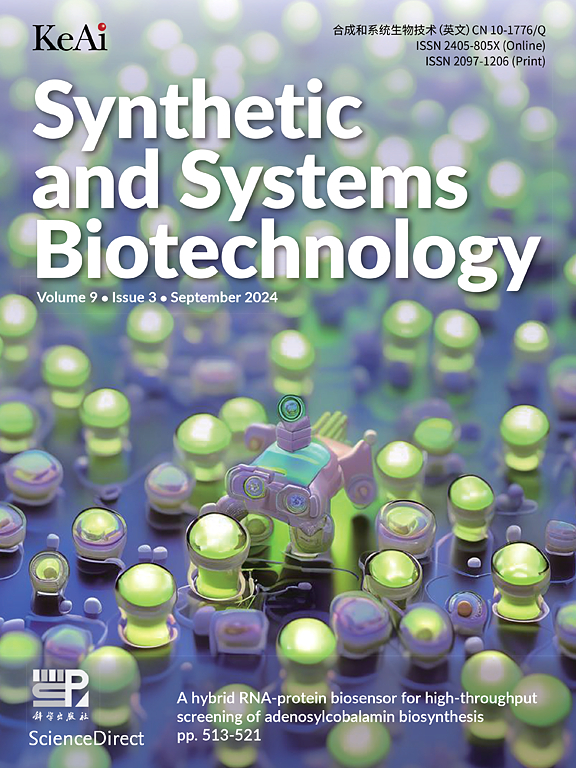调控酿酒酵母生产无机多磷酸盐的系统研究
IF 4.4
2区 生物学
Q1 BIOTECHNOLOGY & APPLIED MICROBIOLOGY
引用次数: 0
摘要
无机聚磷酸盐(polyP)是一种由正磷酸盐残基组成的线性聚合物,在真核生物的血液凝固、免疫调节和翻译后蛋白修饰等多种生物过程中发挥着重要作用。值得注意的是,与短链息肉相比,长链息肉(>;100个磷酸单位)具有不同的生物功能。虽然酿酒酵母是一个很有前途的polyP生物合成微生物平台,但polyP代谢的遗传调控机制仍不清楚。在这里,我们系统地研究了酵母细胞内polyP水平和链长动力学的遗传决定因素。通过筛选55个单基因敲除菌株的文库,我们确定了6个突变体(Δddp1, Δvip1, Δppn1, Δppn2, Δecm33和Δccr4)表现出息肉p积累增加,而vtc1, kcs1, vma22, vma5, pho85, vtc4, vma2, vma3, ecm14和vph2的缺失导致息肉p几乎完全消失。随后在Δppn1背景下的组合缺失表明,Δppn1Δvip1双突变体在polyP浓度(53.01 mg-P/g-DCW)和链长方面实现了协同增强,这是由于ATP可用性增加和多磷酸酶活性降低。利用CRISPR/ cas9介导的Δppn1Δvip1过表达,我们设计了菌株PP2 (vtc4过表达),其polyP产量(62.6 mg-P/g-DCW)相对于野生型BY4741增加了2倍,主要合成长链物种。机制上,qRT-PCR分析证实PP2表现出46倍的vtc4上调,并伴有编码基因ppn2、ddp1和ppx1的多磷酸酶下调。本研究对酵母中无机多磷酸盐的合成调控进行了系统研究,为设计高产多磷酸盐生产菌株提供了合成生物学策略,促进了对无机多磷酸盐的基础认识和生物技术应用。本文章由计算机程序翻译,如有差异,请以英文原文为准。
A systematic study of regulating inorganic polyphosphates production in Saccharomyces cerevisiae
Inorganic polyphosphate (polyP), a linear polymer of orthophosphate residues, plays critical roles in diverse biological processes spanning blood coagulation, immunomodulation, and post-translational protein modifications in eukaryotes. Notably, long-chain polyP (>100 phosphate units) exhibits distinct biological functionalities compared to shorter-chain counterparts. While Saccharomyces cerevisiae serves as a promising microbial platform for polyP biosynthesis, the genetic regulatory mechanisms underlying polyP metabolism remain poorly elucidated. Here, we systematically investigated the genetic determinants governing intracellular polyP levels and chain length dynamics in yeast. Through screening a library of 55 single-gene knockout strains, we identified six mutants (Δddp1, Δvip1, Δppn1, Δppn2, Δecm33, and Δccr4) exhibiting elevated polyP accumulation, whereas deletions of vtc1, kcs1, vma22, vma5, pho85, vtc4, vma2, vma3, ecm14, and vph2 resulted in near-complete polyP depletion. Subsequent combinatorial deletions in the Δppn1 background revealed that the Δppn1Δvip1 double mutant achieved synergistic enhancement in both polyP concentration (53.01 mg-P/g-DCW) and chain length, attributable to increased ATP availability and reduced polyphosphatase activity. Leveraging CRISPR/Cas9-mediated overexpression in Δppn1Δvip1, we engineered strain PP2 (vtc4 overexpression), which demonstrated a 2-fold increase in polyP yield (62.6 mg-P/g-DCW) relative to wild-type BY4741, with predominant synthesis of long-chain species. Mechanistically, qRT-PCR analysis confirmed that PP2 exhibited 46-fold up-regulation of vtc4 coupled with down-regulation of polyphosphatases encoding genes, ppn2, ddp1, and ppx1. This study performed a systematic study of regulating inorganic polyphosphates production in yeast and provides a synthetic biology strategy to engineer high-yield polyP-producing strains, advancing both fundamental understanding and biotechnological applications.
求助全文
通过发布文献求助,成功后即可免费获取论文全文。
去求助
来源期刊

Synthetic and Systems Biotechnology
BIOTECHNOLOGY & APPLIED MICROBIOLOGY-
CiteScore
6.90
自引率
12.50%
发文量
90
审稿时长
67 days
期刊介绍:
Synthetic and Systems Biotechnology aims to promote the communication of original research in synthetic and systems biology, with strong emphasis on applications towards biotechnology. This journal is a quarterly peer-reviewed journal led by Editor-in-Chief Lixin Zhang. The journal publishes high-quality research; focusing on integrative approaches to enable the understanding and design of biological systems, and research to develop the application of systems and synthetic biology to natural systems. This journal will publish Articles, Short notes, Methods, Mini Reviews, Commentary and Conference reviews.
 求助内容:
求助内容: 应助结果提醒方式:
应助结果提醒方式:


